Avacyn-gle Ladies, Part 2
Last week, I started telling stories about individual Avacyn Restored cards and cycles. I only got to F, which means I have more stories to tell. Gee. No, G. Get to it.
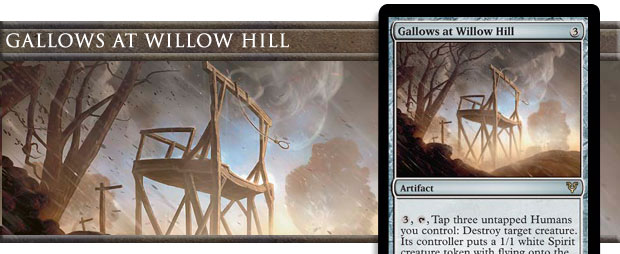

This card was originally designed in Dark Ascension. We were looking for horror tropes and someone suggested gallows. As this was gallows as a horror trope, obviously an angry mob had to lynch you; so if you look at the mechanic, that's what it does. You have to get three creatures together—getting them riled up is your job—and they will force a creature against its will to go to the gallows, resulting in a little ghost for the controller of that creature.
I'm not sure why this got moved to Avacyn Restored. Possibly it got cut for space and Avacyn Restored didn't want to let an awesome card go unprinted. Perhaps it felt more like something the rallying humans would want. I'm honestly not sure. My big concern is to just make sure a cool card like this ends up somewhere in Innistrad block, as this is the block that it made the most sense to print it.
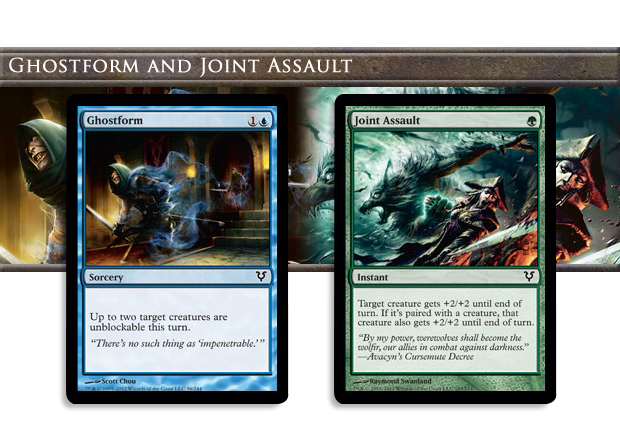
One of the things that happens in design is that you start to figure out themes you want to run through your set. Then what you tend to do is create a spectrum. At one end are obvious cards that call out exactly what you're doing—for example, Joint Assault. Get it? Soulbond is one of our major mechanics. Things are going to pair up. This spell rewards that by spelling it out. More than spelling it out, it demands you make use of the theme in question, in this case soulbond.
Ghostform is doing a similar thing but more subtly. It too plays into the paired creatures theme, but it doesn't call out soulbond by name. For example, you don't have to make paired creatures unblockable. You could just choose any two creatures. So why bother making cards like Joint Assault? Why not make all the cards as flexible as possible?
The answer is the reason for the spectrum in the first place. Part of having themes is making sure players see them. I know experienced players will groan, "Why not just let players discover these things at their own pace?" The answer is that certain players will never see the themes unless they're called out.
There are lots of different types of Magic players and we have to make cards to give all of them what they need. Some players need hand holding. Some don't. One end of the spectrum helps the former and the other side is for the latter. Note that this is a spectrum, though, because the amount of support the players need is a continuum.
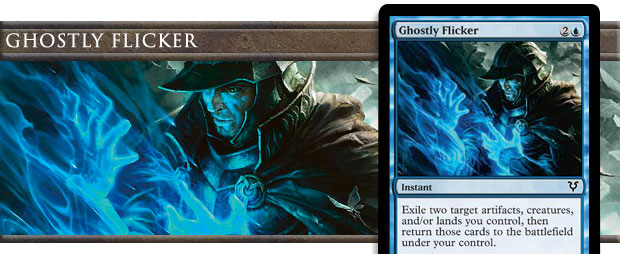

Hey look, another card playing into the two theme, but that's not why I want to talk about this card. I actually want to talk about the flickering theme in Avacyn Restored, so I've just chosen this card as the representative. Let's take a step back and look at what flickering is.
Last week, I talked about designing Flicker in Urza's Destiny, but I realized after I'd written it that I had designed my first flicker effect before Urza's Destiny, back in Tempest design. The card was a blue instant called Tabula Rasa. Tabula rasa means "blank slate" in Latin, and it ties into the idea that humans are born in a neutral state and are capable of becoming whatever they want through education and training. For those who know the core blue/green conflict, this is blue's side, which is why when I first made it I did it as a blue card (and it is also why blue gets to be one of the two colors that flickers in the color pie).
Flicker ended up in white in Urza's Destiny because I was looking for something for white to do. I had made a vertical cycle in each color (a card in common, uncommon, and rare in that color) and I already had a role for blue—creatures with enhancements when enchanted—ironic in retrospect as that is more white than blue). White was the other color that made sense philosophically—white has this sense of starting over and giving everything a fair chance—so I put it into white.
When making flicker effects, you have a few decisions to make:
Decision #1: Does the effect work on only your permanents or on everyone's permanents?
Another way to think of this is, "Do we want the flicker cards to enhance your cards or hurt your opponents' cards?" You tend to flicker things of yours that you want to come back into play, such as cards with "enter the battlefield" (ETB) effects, while you tend to flicker things of your opponents they don't want to have leave and come back, such as creatures with +1/+1 counters and Auras. Also, note that flickering a token creature essentially kills it.
The reason we don't just hit your opponent's permanents is that hitting your own is fun to do. There's little reason not to let you do that in addition to hitting the opponent's permanents, as you are more inclined to punish the opponent than help yourself.
Decision #2: Is it going to come back immediately or at end of turn?
Each brings with it different uses. Immediately tends to be slightly better for using on your own permanents because it allows you to make things happen before you attack. Flickering until end of turn tends to be slightly better on your opponent's permanents because there is value in just having them be away for the turn. For instance, it allows you to remove blockers.
Decision #3: Does the card come back to its controller or its owner?
When a card is flickered you could either treat it as being a fresh new card that does what the card would do if it were a brand new card just cast or you can have it return from whence it came. As a general rule, Ramp;D wants to be consistent with this decision. The desire for consistency is so players have a reasonable expectation of how a certain mechanic works.
Let's examine where we came down with flickering for Avacyn Restored.
Decision #1: The mechanic was chosen because it worked so well with the good guys, who had a lot of ETB effects and soulbond. As we wanted you to use the flickering on yourself, we chose the option where that's all you could do. Had we chosen to let you use the mechanic on your opponent, some amount of the time you would have done that rather than focus on the reason we wanted the mechanic in the first place.
Also, the early design version of soulbond (I'll get to soulbond's design one of these weeks) only triggered when your soulbond creature came into play. This meant you could flicker the paired creature to unpair it. This allowed flickering to actively work against soulbond, one of the key mechanics of the set. Part of not allowing you to hit the opponent's permanents was to keep it from messing with soulbond. (The change in development to allow things to pair when any creature entered the battlefield negated this issue.)
Decision #2: Once we decided to only allow players to target their own permanents, the insta-flicker became more attractive, as that version allows more tricks for you. For example, if you flicker a soulbond creature you can now re-pair it to another creature. If the flicker's an instant, you can do this mid-combat. If the flicker's a sorcery, you can re-pair it before combat and the newly paired creature can attack. (The creature with soulbond cannot as it then has summoning sickness.)
Decision #3: This is the biggest change from the way things used to be. In Avacyn Restored, the flickered permanent returns under the control of the person who previously controlled it pre-flicker. This was a decision made in development. My best guess was that development felt that most people incorrectly played a flicker effect on a creature you controlled but didn't own (for example, something you've stolen with an effect) and this change was to make the effect work the way most people thought it did. I'm pretty sure this decision is a switch to how we will now do flicker effects in the future.
So as you can see, a little thing like a flicker effect has a lot more going on under the hood than you might realize.
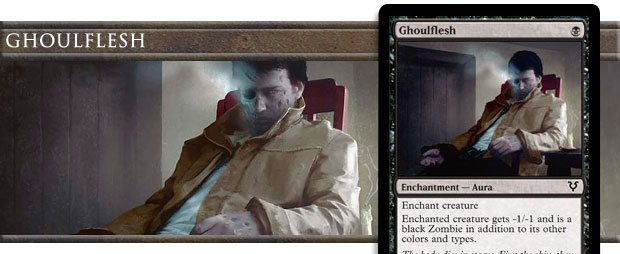

One of the interesting things about working on a single game's design for so long is that you can start to see what things stand up to the test of time. What are the ideas that keep bubbling up because something about them just speaks to the players and designers? I'm fascinated by these things because I can tell there is something very interesting psychologically underneath these mechanics. Something about them just grabs people.
I bring this up on Ghoulflesh because it uses a mechanic that dates back to Alpha and this card:
Note that I'm not talking about reanimation, although that is something else that seems to be an idea we'll never leave behind (even if we have weakened its power over the years). No, I'm talking about a little clause on both cards lowering the power by 1. The flavor here is simple but potent—being raised from the dead as a zombie takes a little bit out of you. You're undead; you're not quite alive. As such, you're a little less of a threat. Ghoulflesh does -1/-1 instead of -1/-0 because we tend to like to square our stats when we can these days, to make them easier to grok. It also lets Ghoulflesh have a little bit of play as a removal card for small creatures.
As you can see, my years of design has gotten me to really appreciate the small nuggets of a design that transcend the splash of the moment. I firmly believe that improving one's art is about getting better at the details and learning to appreciate things that often get glossed over but are doing important work.
That's why I look at Ghoulflesh and think back to Animate Dead.
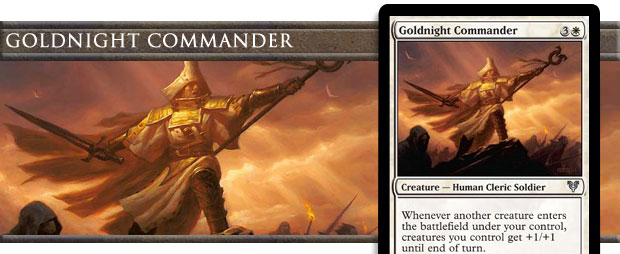

One of the techniques for doing design that's popped up over the last few years is for the design team to have members choose different aspects of the set and then build decks to show it off. The reason to do this is that by building a deck you have the best insight to see if you're giving the theme enough to work with. Also, when you discover a gap, you are in the best place to design a card specifically to fill that gap. Goldnight Commander's design story is exactly that.
Brian Tinsman (Avacyn Restored's lead designer) wanted us to build decks to reflect different subthemes in the set. I volunteered for a red/white Human deck. See, the good guys are winning, which meant that white and most of blue, red, and green were clearing Innistrad of its monsters. That meant that blue, red, and green each needed an identity for its good guys.
Most of red's good guys were Humans, so I set out to build a deck that played into the synergy between red and white and played up some of the Human tribal cards we had. One of the shticks of the good guys in Avacyn Restored is that they were all positive and about bringing life into the world. We reflected this by giving them a lot of ETB effects. Similarly, we also made a number of cards, mostly creatures, that were rewarded for creatures coming into play.
As the deck was red/white, I knew it wanted to be aggressive. When red and white get together they tend to want to attack, so that was the plan. What I found when I played the deck, though, was that it didn't quite have enough juice. I needed to ramp up the pressure a little.
Goldnight Commander came about because I wanted to create a creature with a "whenever another creature enters the battlefield" trigger. I knew I wanted the creature to encourage attacking and I wanted it to be white. Goldnight Commander was basically me sticking all my design needs together and making a card that met them all.
If you draft red/white in Avacyn Restored (my personal favorite thing to draft—please don't read this as it being the most powerful because if you do, you don't know me at all), know that I would draft this card.


It's time to see how Melvin you are. Look at Grave Exchange and tell me what you see. I'll wait.
If you said, "Ooh, parallel design structure," you're a Melvin.
Let me explain. What does this card do? It makes creature cards change zones with the graveyard. One effect puts a creature into the graveyard and the other removes a creature card from the graveyard. You get the zone exchange that is positive (graveyard è hand) and your opponent gets the one that is negative (battlefield è graveyard).
Okay Melvin, can you figure out where the card started?
Yes, the original design returned the creature card to the battlefield, which was an exact mirror of the other effect. Unfortunately, that turned out to be too good to cost at anything reasonable so the creature card was sent to the hand instead.
Creative added a flavor to make sense of the card, but at the core this card was a Melvin design.
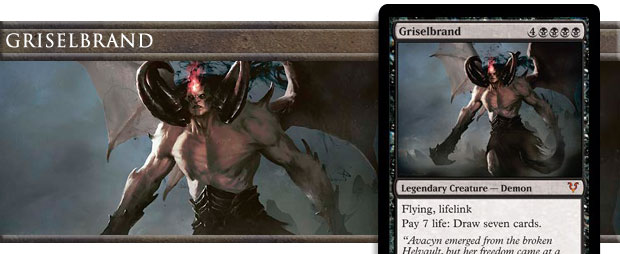

One question about this card has dwarfed all others: "Why doesn't he cost seven mana?" Why is this the number one question? Because the card breaks a cardinal rule of aesthetics.
What are aesthetics? I talked about it a bit in article I wrote ten years ago called "Zen and the Art of Cycle Maintenance." For those who don't want to read the link, here's the short version: Aesthetics is the science of beauty. People like to think of beauty as being in the eye of the beholder, but science has shown that there are just certain things the human brain finds more beautiful. (Feel free to read the link for more on this.)
One of the things the human brain loves are patterns. When four numbers of a card are sevens, the brain really wants the fifth number to be as well. (Actually, the brain probably wants seven numbers that are all sevens but pattern completion can lead you astray if you're not too careful.)
I thought Griselbrand was designed at seven mana because if I designed the card, of course, it would cost seven. Turns out that it got designed pretty close to how it got printed. Brian even put a note in the file for development "not to mess with it." The card was #1 in our internal rare poll, so Dave Humpherys (the set's lead developer) left it alone.
I asked Dave if he ever considered making it seven and he said the issue had come up and the developers agreed it was already pushing things at eight, so the card stayed as was.
One last little tidbit. When looking back through the developer's notes for this card, I found very few comments by me on it. One I did find, though (way back from mid-design): "This should cost seven."


A big part of the design of both Innistrad and Dark Ascension was finding tropes to design top-down from. One idea we had in Innistrad was the idea of a priest who turned undead. For those who have never played a game with turn undead, the idea is that a cleric uses his faith-based magic to destroy the undead—usually zombies.
We designed a card in Innistrad but ended up not having space for it. We talked about the idea in Dark Ascension but as we were trying to show the humans on the run, having a priest that mowed down zombies felt wrong. Luckily, Avacyn Restored proved to be the perfect place for the trope because we wanted to show humans kicking the monsters' butts.
In the end, we made a card that was useful against non-zombies (as making a card only good against zombies would be at best a sideboard card and then only against a zombie-heavy deck—something hard to find in Avacyn Restored Limited) but excelled when fighting the walking undead.
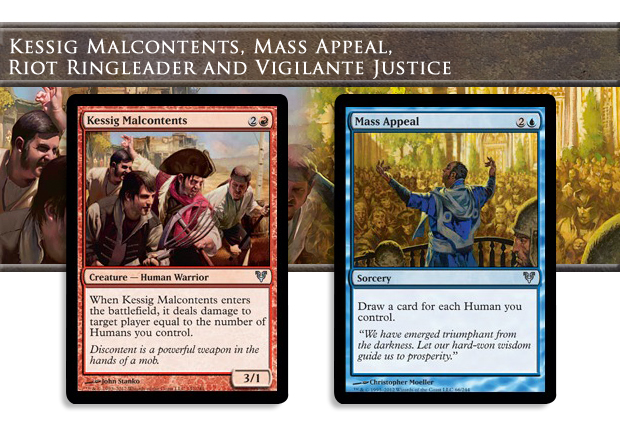
Innistrad and Dark Ascension both have a strong tribal subtheme. We felt like it would be wrong for Avacyn Restored to not have some tribal component. The problem was that four out of the five supported creature types were monsters, which we wanted to show were on the run in this set. That meant we had to rely more on the one creature that was dominant—the Humans.
To help set this up, Dark Ascension dialed down the Human tribal to leave some room for Avacyn Restored to ramp it back up. To add something new to the mix, we decided to stick some of the Human tribal into colors that hadn't had it before. White (and artifacts), obviously, was king of Human tribal in Innistrad. Black didn't make any sense as black was the home for bad guys, few of which were human.
Green was already focusing on soulbond and Innistrad had some green Human tribal, so we instead decided to focus the Human tribal primarily in red and secondarily in blue. This gave a reason for red to want to be played with white, as white still had the most Humans. Note that the Human tribal plays into the style of deck that color wants, with red's tribal being more aggressive and blue's being more passive.
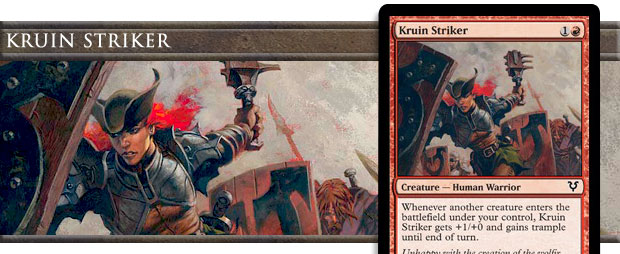

When I played my red/white Human deck in design playtests, this was the card that first made me see where the deck wanted to go. The card at the time granted +2/+0 and was very powerful. (It would later get toned down in development.) It got me to realize that the red/white deck was going to be all about playing a lot of small creatures, many Human, that would work together to take down the opponent. I loved how it captured the "we all have to work together" feel we wanted from the good guys.
- Oh, K
Well, I started at G and managed to get to K. Here's hoping Part 3 goes a little faster. I hope you all enjoyed this trip through Avacyn Restored. I'd love to hear any feedback through any of my social channels (Twitter, Tumblr, and Google+), in my email, or in the thread to this column.
Join me next week when I start talking about the back half of the alphabet.
Until then, may you have too many stories to tell in one sitting.




